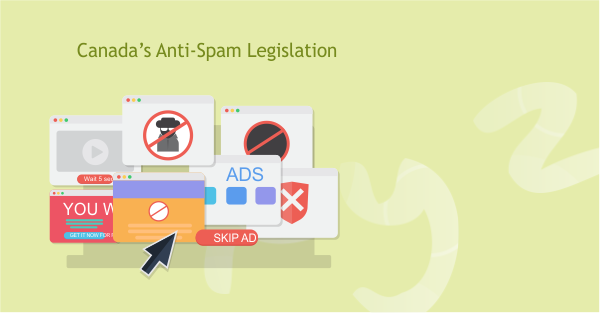The internet has revolutionized the way we communicate and do business, but with it comes the problem of spam. Spam, also known as junk mail, is unsolicited and unwanted messages that flood our inboxes. Spam can be annoying, time-consuming, and even dangerous as some may contain viruses or phishing links. Fortunately, there are laws in place to help combat spam, such as the Canadian Anti-Spam Law (CASL).
If you have received spam and want to make a complaint, the following steps will guide you on how to make a CASL anti-spam complaint:
Identify the Spam
Before making a complaint, it is important to identify the spam that you received. This can be done by checking the email header or looking at the sender’s email address. Spam messages are usually sent from fake or suspicious email addresses.
Gather Evidence
Once you have identified the spam, it is important to gather evidence to support your complaint. This includes the email header, message content, and any other relevant information such as the sender’s email address and the date and time the spam was received.
Contact the Sender
Before making a complaint, you should contact the sender and request to be removed from their mailing list. If you continue to receive spam after requesting to be removed from their mailing list, you can proceed to make a complaint.
Make a Complaint
To make a complaint, you can visit the Government of Canada’s Spam Reporting Centre website (www.fightspam.gc.ca) and fill out a complaint form. The form will ask for details about the spam you received and any supporting evidence. Once you have submitted your complaint, it will be reviewed by the Canadian Radio-television and Telecommunications Commission (CRTC).
Follow Up
After making a complaint, it is important to follow up to ensure that action has been taken. The CRTC will investigate the complaint and take appropriate action against the sender if they are found to be in violation of CASL.
Spam can be a nuisance and a potential threat to your online safety. However, by following these steps and making a CASL anti-spam complaint, you can help to combat spam and protect yourself and others from unwanted messages. Remember to always be vigilant when opening emails from unknown senders and report any suspicious messages immediately.
What are the fines for a CASL violation?
The Canadian Anti-Spam Legislation (CASL) imposes fines for violations related to unsolicited commercial electronic messages (CEMs), the installation of computer programs, and the alteration of transmission data. The fines for a CASL violation can be significant and may vary depending on the severity of the offense.
For individuals, the maximum penalty for a CASL violation is $1 million per violation, while for businesses, it can be up to $10 million per violation. In addition to these financial penalties, individuals and businesses can also face reputational damage, loss of customer trust, and legal fees.
Furthermore, the CRTC has the power to impose monetary penalties, issue warning letters, enter into undertakings, and seek court orders to stop CASL violations.
It’s worth noting that CASL allows individuals or businesses to voluntarily disclose a violation to the CRTC and to enter into an undertaking to address the violation. By doing so, they may be able to avoid or reduce penalties.
In conclusion, the fines for a CASL violation can be significant, and individuals or businesses that violate CASL can face financial penalties, reputational damage, and legal fees. Therefore, it’s important to ensure that all electronic messages and practices comply with CASL to avoid potential violations and their associated consequences.
Notable CASL fines to date
There have been several fines issued for violations of the Canadian Anti-Spam Legislation (CASL) since it came into effect in 2014.
Notable CASL violations include:
- Compufinder – $1,100,000
- Rogers – $200,000
- Porter Airlines – $150,000
- Kellogg – $60,000
- Plentyoffish – $48,000
- Mr William Repanos – $15,000
These fines demonstrate that the CRTC takes CASL violations seriously and is willing to impose penalties on individuals and businesses that fail to comply with CASL’s requirements. It’s important for individuals and businesses to understand and comply with CASL’s rules to avoid potential violations and their associated penalties.
How can organizations avoid a CASL fine?
To avoid a fine under the Canadian Anti-Spam Legislation (CASL), organizations must ensure that they comply with the requirements of the law when sending commercial electronic messages (CEMs) and installing computer programs. Here are some steps that organizations can take to avoid a CASL fine:
- Obtain express consent: Organizations must obtain express consent from individuals before sending CEMs. This means that individuals must provide their explicit consent to receive commercial messages, either in writing or verbally. Organizations must keep records of consent, including when and how consent was obtained.
- Provide identification information: All CEMs must identify the sender of the message, including their name and contact information. This helps individuals know who is sending the message and how to contact them if necessary.
- Include an unsubscribe mechanism: CEMs must provide a clear and conspicuous unsubscribe mechanism, allowing individuals to opt-out of receiving further messages. The unsubscribe mechanism must be functional for at least 60 days after sending the message.
- Maintain accurate records: Organizations must keep accurate records of all CEMs sent and received, including consent, opt-out requests, and any changes to contact information.
- Train staff on CASL compliance: It’s important to ensure that all staff who send CEMs or install computer programs are aware of CASL’s requirements and understand how to comply with them.
- Conduct regular compliance reviews: Organizations should conduct regular compliance reviews to ensure that their policies and practices comply with CASL’s requirements. This includes reviewing consent records, identifying and correcting compliance issues, and providing training to staff where necessary.
By taking these steps, organizations can minimize their risk of a CASL violation and the associated penalties. It’s important to note that CASL violations can be costly, both financially and in terms of reputation, so it’s important to prioritize compliance with this legislation.






